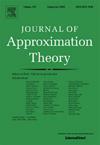A lower bound for the Lebesgue constant of the Morrow–Patterson points
IF 0.6
3区 数学
Q2 MATHEMATICS
引用次数: 0
Abstract
The study of interpolation nodes and their associated Lebesgue constants is a cornerstone of numerical analysis, directly influencing the stability and accuracy of polynomial approximations. In this paper, we examine the Morrow–Patterson points, a specific set of interpolation nodes introduced to construct cubature formulas with the minimal number of points in a square for a fixed degree . We prove that their Lebesgue constant has minimal rate of growth of at least .
莫罗-帕特森点的勒贝格常数的下界
插值节点及其相关勒贝格常数的研究是数值分析的基石,直接影响多项式近似的稳定性和精度。在本文中,我们研究了Morrow-Patterson点,这是一组特定的插值节点,用于构造固定次数为n的方形中点数最少的立方体公式。我们证明了它们的Lebesgue常数的最小增长率至少为O(n2)。
本文章由计算机程序翻译,如有差异,请以英文原文为准。
求助全文
约1分钟内获得全文
求助全文
来源期刊
CiteScore
1.90
自引率
11.10%
发文量
55
审稿时长
6-12 weeks
期刊介绍:
The Journal of Approximation Theory is devoted to advances in pure and applied approximation theory and related areas. These areas include, among others:
• Classical approximation
• Abstract approximation
• Constructive approximation
• Degree of approximation
• Fourier expansions
• Interpolation of operators
• General orthogonal systems
• Interpolation and quadratures
• Multivariate approximation
• Orthogonal polynomials
• Padé approximation
• Rational approximation
• Spline functions of one and several variables
• Approximation by radial basis functions in Euclidean spaces, on spheres, and on more general manifolds
• Special functions with strong connections to classical harmonic analysis, orthogonal polynomial, and approximation theory (as opposed to combinatorics, number theory, representation theory, generating functions, formal theory, and so forth)
• Approximation theoretic aspects of real or complex function theory, function theory, difference or differential equations, function spaces, or harmonic analysis
• Wavelet Theory and its applications in signal and image processing, and in differential equations with special emphasis on connections between wavelet theory and elements of approximation theory (such as approximation orders, Besov and Sobolev spaces, and so forth)
• Gabor (Weyl-Heisenberg) expansions and sampling theory.

 求助内容:
求助内容: 应助结果提醒方式:
应助结果提醒方式:


